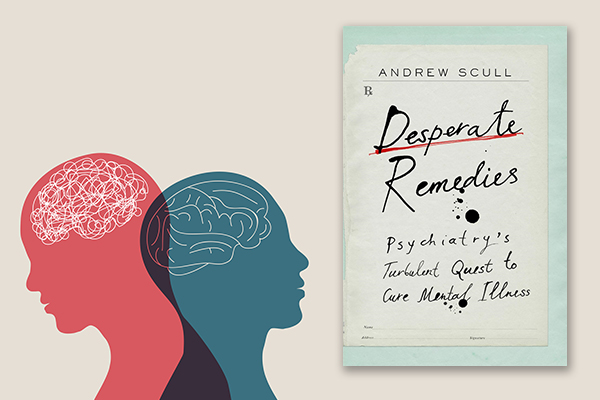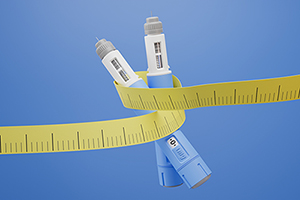



| By Dr. Ronald Hoffman

For centuries, medicine has grappled with psychiatric illness, wielding a variety of techniques. Nevertheless, success has been at best marginal; a recent study of antidepressants and psychotherapy in the treatment of major depressive disorder has shown a response rate of just 24%. For schizophrenia and psychosis, the results have been even more abysmal. Random violence and rampant homelessness attest to the pervasiveness of unaddressed psychiatric disorders; childhood and adolescent anxiety, depression, and behavioral disorders are soaring in prevalence.
For those patients who obtain relief from modern psychiatric drugs, it’s often partial and transient, and comes at the cost of life-impairing side effects.
But today’s therapies are benign by comparison with some of the barbarities perpetrated in the past on persons suffering from mental illness. Andrew Scull has provided us with a meticulously-researched history of these desperate remedies—and it’s a cautionary tale about the extremes to which medical hubris can lead us, with true contemporary relevance.
The underlying theme of Desperate Remedies is that the psychiatric profession has gyrated from one misguided treatment paradigm to another, culminating in its current infatuation with psychopharmacology, often with disastrous results. It’s a true illustration of how blind zeal for “cures” has led to terrible excesses, not just in psychiatry, but in all arenas of medicine.
Until the mid-20th Century, people with mental disorders were confined to asylums, where conditions were horrific. Patients were warehoused there with little hope of recovery. Straightjackets, padded cells, beatings, forced immersion in tubs of ice water, and sexual abuse were rampant.
With the popularization of Darwin’s evolutionary theories of “survival of the fittest”, the notion developed that the insane represented a form of hereditary degeneracy. On the contrary, sophisticated modern gene-mapping has been hard put to find one or even a constellation of genes that make people schizophrenic or depressive. But 19th and early 20th Century eugenicists became convinced that the human bloodline should be purged of “inferior” stock. This led to mass (involuntary) sterilization in asylums and was the antecedent to the Nazis’ extermination of “life unworthy of life”; Hitler drew his inspiration from America.
As the Germ Theory came into prominence with the discoveries of Pasteur and Koch, it was recognized that a considerable proportion of the denizens of insane asylums were tertiary syphilitics, suffering from organic brain disease. Consequently, perhaps in an effort to keep up with their biomedical peers, psychiatrists signed on to the theory that chronic infections were a source of toxicity that disrupted brain function. They experimented on asylum inmates, pulling teeth, performing tonsillectomies, hysterectomies (with the same etymological root as the word hysteria), and even colectomies, to no avail.
Fever therapy enjoyed a brief hey-day, with patients receiving injections of malaria-infested blood.
With the advent of insulin in the 1920s, it was accidentally discovered that administration of too much insulin could result in comas or seizures. Zealous psychiatrists then came up with the idea that insulin shock therapy could “reboot” the scrambled brains of mental patients. When they didn’t die outright, many patients suffered from permanent brain or organ damage. Because these trials weren’t controlled and subject to enormous practitioner bias, it took decades to recognize these draconian interventions were fruitless.
As electricity came into vogue, the idea arose that shocks could be administered to the brain as an alternative to insulin coma therapy. Patients were strapped to a table and sometimes received series of scores of electroshock treatments. The practice was dramatized in the 1975 movie “One Flew Over the Cuckoo’s Nest”. It wasn’t clear at times whether patients’ seeming improvements were due to the shocks themselves or the prospect of painful reprisals on the electroshock table as punishment for unruly behavior. Common consequences of early electroshock were wholesale memory erasure and broken bones due to intense muscular spasms. Nevertheless, electroshock remained popular until the advent of drug therapy in the 1950s relegated it to the scrap heap—only to be resurrected in a more refined form lately.
In an effort to emulate the mounting successes of modern precision surgery, psychiatrists then came up with the idea that lobotomy—selective ablation of the “troublesome” part of the brain—could alleviate mental problems. Thus began a decades-long era when patients underwent therapeutic brain destruction. At first performed by expert neurosurgeons, a Portuguese neurologist named António Egaz Moniz innovated a technique that enabled even minimally-trained asylum personnel to perform lobotomies by driving a modified ice pick through the orbital bones with a mallet. In this way, dozens of patients could efficiently be lobotomized in a single day, as Moniz proudly demonstrated while touring insane asylums to instruct receptive staffers in the method. He was later awarded a Nobel Prize.
Partially as a reaction to these excesses, a schism developed in psychiatry in the 20th Century between stalwarts of the organic brain disease theory and psychotherapists influenced by the concepts of Sigmund Freud and Karl Jung. The therapy community was further divided by internecine warfare and competition for patients between different schools, variously embracing or distancing themselves from the Freudian orthodoxy. History records that many shrinks seemed nuttier than their patients.
Nevertheless, popular culture in movies and books stoked the public’s taste for excavating hidden trauma on the therapist’s couch. In the end, it was short-term interventions like Cognitive Behavioral Therapy (CBT) that emerged triumphant, although more suited for ordinary phobias and neuroses than deep-seated psychoses.
In the 1950s, the accidental discovery that chlorpromazine (Thorazine) could calm schizophrenic patients led to its widespread deployment. This, combined with the reluctance of state governments to bear the enormous costs of warehousing the insane, and increasing public awareness of the horrors of asylums, led to wholesale de-institutionalization. By the 1970s, the inpatient population had declined precipitously from half a million to a few thousand. Even with the advent of newer anti-psychotic medications, patients released into the community mostly remained chemically straight-jacketed, not cured.
According to Scull, Thomas Reynolds, who headed one subdivision of the vast federal St. Elizabeth’s Hospital in Washington, DC, warned that:
“If we examine the actual quality of the lives of these people we now return so easily to the community, in their homes and foster homes and halfway houses, taking their Thorazine tablets or their Prolixin injections, we will discover that the great majority, while outwardly sane and tractable, are living utterly barren and blasted lives.… We have created a kind of slow spiritual euthanasia with chemical agents, whose primary function is get the patients away from us so that by not seeing the poverty of their lives, we may cease feeling any responsibility for the matter.”
As for less debilitating psychiatric conditions like depression and anxiety, the impact of new drug fixes has only seemed to magnify their prevalence, according to Scull. Diagnostic creep has extended the reach of psychopharmacology to address hitherto normal human conditions like grief, loneliness, selfishness (narcissistic personality disorder), childhood misbehavior (pediatric bipolar disorder), trauma (PTSD), inattention (ADHD) and shyness (social phobia).
But the profitable pipeline for psychiatric drugs is drying up, according to Scull:
“In the words of the former head of neuroscience at Eli Lilly and Amgen, ‘Psychopharmacology is in crisis. The data are in, and it is clear that a massive experiment has failed: despite decades of research and billions of dollars invested, not a single mechanistically novel drug has reached the psychiatric market in more than 30 years.’”
The book concludes on a pessimistic note:
“It would be astonishing if the social and economic devastation wrought by the pandemic does not contribute to more mental distress and breakdowns among those most exposed to its ravages, and preliminary data suggest that these consequences are already surfacing . . . the psychosocial effects of these stresses can, in some cases, be expected to be profound and long-lasting, predisposing some people to heightened rates of mental disturbance for many years to come.”
My minor quibble with Scull’s otherwise excellent account is his elision of plausible lifestyle factors as potential fixes for mental disorders. I didn’t expect a full-throated endorsement of “Orthomolecular Medicine” from this conservative scholar, but the impacts of diet, exercise, sleep optimization, microbiome interventions and relaxation techniques are considerable and not to be ignored. See my book review and interview with Dr. Christopher Palmer, author of Brain Energy and Dr. Drew Ramsey on the subject of the emerging field of nutritional psychiatry. Even the burgeoning science of transcranial magnetic stimulation (TMS) deserves a nod here—unless it, too, should eventually join the cavalcade of misbegotten psychiatric vogues like others enumerated in Desperate Remedies.
One thing’s for sure—we need to do better. And learn from the mistakes of the past.
Though we think of declining estrogen as the hallmark of menopause, it's actually common for…

Up to 12 percent of Americans have ulcers at some point in life. Peptic ulcers…
Gallbladder disease is a modern illness. An estimated 20 million Americans have gallbladder disease. The…

New, more powerful weight loss drugs: Drugs like Wegovy, Rybelsus, Ozempic and Mounjaro/Zepbound are revolutionizing…

According to the Lancet, autoimmune disease affects one in ten people globally and it’s now…

This past week we were regaled with headlines like: High levels of niacin may increase…

Leyla Weighs In: The Erosion of Trust in Nutritional Research

Our virtual voicemail is open 24/7, so there's no need to wait to submit your questions for Dr. Hoffman. Leave a message, and you may hear your question featured on the Intelligent Medicine radio program!